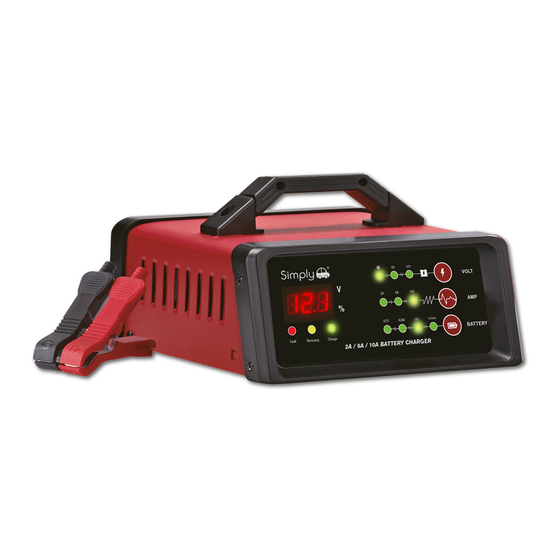
Summary of Contents for Simply BTC-6010
- Page 1 2A/6A/10A 6V/12V AUTOMATIC BATTERY CHARGER INSTRUCTION MANUAL BTC-6010 Please read before use Save this manual for future reference...
-
Page 2: Safety Guidelines - Definitions
There are certain applications for which tools and equipment are designed. Simply Auto strongly recommends that this products NOT be modified and/or used for any application other than for which it was designed. Read and understand all warning and operating instructions before using any tool or equipment. - Page 3 WARNING: RISK OF EXPLOSIVE GAS. • Operate the charger as far away from the battery as DC charger cables permit. • Do not expose the charger to rain or snow. • NEVER charge a frozen battery. • NEVER set a battery on top of the charger. •...
- Page 4 Preparing to Charge 1. Determine voltage of battery to be maintained by referring to the vehicle manual. 2. If it is necessary to remove battery from vehicle to charge, or to clean terminal, always remove grounded terminal from battery first. Make sure all accessories in the vehicle are off, so as not to cause an arc.
- Page 5 4. Determine which post of battery is grounded (connected) to the chassis. If NEGATIVE post is grounded to chassis (as in most vehicles), see 5. If POSITIVE post is grounded to the chassis, see 6. 5. For negative-grounded vehicle, connect POSITIVE (RED) clamp from battery charger to POSITIVE (POS, P, +) engine block away from battery.
- Page 6 • Safety Protection: Battery Charger has Over Voltage, Over Heat, Overtime Charging, Short Circuit, and Reverse Polarity Protection to ensure users safety. • Maintains battery charger in stored vehicles. • Fully automatic; When the voltage of the battery is above 0.5V, battery charger will automatically power on to charge the battery, and it will automatically power off when battery is fully-charged.
-
Page 7: Short Circuit
SHORT-CIRCUIT When clamps connecting short-circuit, LED display will show the code, FAULT indicator light in red. WARNING OVERVOLTAGE When charging batteries over rating voltage, LED display will show the code and stop output. WARNING OVERHEAT When charger internal temperature over 125°(257℉),it will stop output and shows code on LCD display. -
Page 8: Charging Instructions
1.Unplug the battery charger AC cord from the AC outlet. 2.Disconnect the battery clamps from the unit at output and cord connector 3.Plug the AC cord into the AC outlet (230V~ 50/60 Hz) 4.Press the battery selection and current selection to proper setting 5.Connect the RED POSITIVRE clamp to the POSITIVE post of the battery. - Page 9 Reason Possible solutions Power On/Off Problem • Check that the charger is properly connected to a live AC Outlet. • Check that the correct battery selection setting has been selected for the battery being charged. Power Off Unit not charging, Screen indicates •...
-
Page 10: Battery Connection
BATTERY CONNECTION If the charger does not connected properly, charging will not start, Make sure the charger is connected to the battery and the connection points are clean and making a good connection or make sure no reverse connections at the battery. CHARGING COMPLETION Charge completion is indicated by the charging status indicator turning on ( LED indicator shows fully charged state). -
Page 11: Specifications Parameters
9. Never charging on the condition that contains flammable and explosive gases. 10. Do not come close to the battery during charging. 11. The battery should be placed in ventilated well area. 12. The product should not be operated by children, those who have psychiatric disorders and lack of experience, except that is supervised and instructed by supervisor.





Need help?
Do you have a question about the BTC-6010 and is the answer not in the manual?
Questions and answers